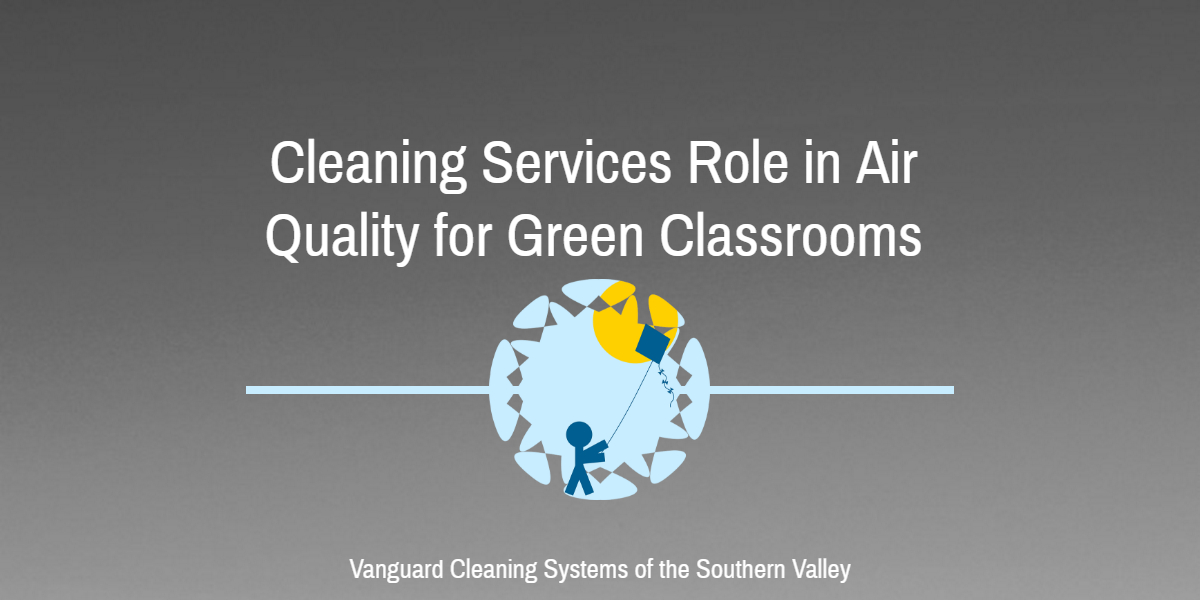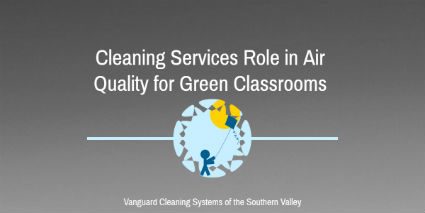Green cleaning services and products play a vital role in air quality solutions for LEED and U.S. Green Building Council certified schools, homes, and offices.

Cleaning Services and Air Quality Solutions to Address LEED Green Classroom Challenges
The control and quality of indoor air is a pillar of LEED Green Classroom Initiatives.
Numerous studies through the years have established the correlation between the quality of indoor air, and the health and performance of students.
Many school districts lack the budget to institute a full rebuild of each classroom to adhere to the highest levels of LEED certification.
However, there are steps that can be implemented, almost immediately, that will significantly improve the quality of life for students, as well as their ability to perform at a higher level.
The process, generically, consists of identifying and removing the cause of toxin introduction into the air, as well as additional methods to cost-effectively reduce the natural VOCs wreaking havoc on the health and wellbeing of our children.
Identify Sources
There are several sources of VOCs that affect the quality of indoor air, many of which can be overlooked without the proper education, including:
- Mold.
- Dust.
- Improper floor coverings and carpeting.
- Inadequate air circulation.
- Outdoor pollution and air quality.
- Aerosol air fresheners and cleaners, and;
- Leaky plumbing and standing water.
Many of these sources require a trained eye and years of experience to identify; lending weight towards the argument that outsourcing green initiatives early on will save your district money in the long run.
See Also:
Identify Practices
In addition to the natural off-gassing of VOCs from environmental sources, many of which are beyond human control, additional chemicals are unintentionally introduced into classrooms by students, teachers, and custodial staff through various activities, including:
- Science experiments of any kind.
- Many types of artistic activities.
- Common electronic equipment, such as printers and photocopiers.
- Air fresheners, and;
- Cleaning and sanitizing chemicals.
Most relevant to green cleaning services is the elimination of hazardous cleaning products.
According to the California Department of General Services;
Many products can contribute to indoor air pollution, such as school furniture, carpets, adhesives, paint, finishes and cleaning products.
Products such as these often contain formaldehyde and other chemicals that can be hazardous to the health of building occupants.
When these products off-gas, they may cause dizziness or induce asthma attacks.
Children are especially susceptible because they respire more in proportion to their body weight.
By using low emitting materials rather than common indoor building materials, schools can eliminate many sources of pollution before they even reach the building site.
Promote Indoor Air Flow
Due to multiple factors, opening doors and windows to increase natural indoor air flow to reduce VOCs and indoor pollutants is not always practical or possible.
A distinct element that would make open doors and windows impractical would be inclimate weather and storms.
Another issue plaguing many classrooms is the lack of storage space for books, paper, and other materials; resulting in their placement over or in front of ventilation systems.
Some inexpensive tips for promoting indoor air flow are:
- Use fans in doorways or windows, as long as they do not obstruct central airflow systems, and do not move the temperature of the room to an uncomfortable degree that will affect attention and learning.
- Newer HEPA filtration systems come with fans to force the flow of clean air, as opposed to passively cleaning as air passes through it.
- If staff members are available, consider opening doors and windows early in the morning to reduce humidity levels while clearing out stagnant classroom air.
If you decide to open doors and windows, keep temperature and outdoor pollution in mind, and pay close attention to local air quality reports to avoid compounding indoor air problems.
Identify Health Effects
The primary reason to identify and eliminate sources and practices that contribute to indoor air pollution is to promote health and remove external factors that can contribute to future medical problems, such as:
- Asthma.
- Allergies.
- Headaches.
- Dizziness.
- Nausea/Vomiting.
- Liver/Kidney Damage.
- Central Nervous System Damage, and;
- Cancer.
For More Information:
Identify Performance Effects
Poor student health, especially long-term, is one of the leading causes of decreased performance due to absenteeism, as well as diminished energy and focus.
According to the Environmental Protection Agency;
Evidence continues to emerge showing that poor indoor air quality (IAQ) can cause illness requiring absence from school, and can cause acute health symptoms that decrease performance while at school.
In addition, recent data suggest that poor IAQ may directly reduce a person’s ability to perform specific mental tasks requiring concentration, calculation, or memory.
Strategies & Tips
- Identify central air vents in classrooms, storage areas, faculty lounges, and administrative offices to avoid blocking the flow, or introducing toxins into connected facilities.
- Report signs of moisture, leaks, damaged windows, or damaged door frames to get an early jump on potential mold or bacteria buildup.
- Class parties aside; avoid allowing the students to eat at their desks.
- Enforce cleanliness policies with lockers and desks.
- Use walkway and entry mats to capture as much dirt as possible, and encourage/enforce a 'wipe your feet' policy.
- Address external sources of pollution, such as dumpsters residing too close to classroom windows, pesticide or lawn fertilizer smell, or fumes from adjacent bus stops.
- Place live plants around the room to absorb toxins.
- Check for Green Seal cleaning product labels, and eliminate all non-USGBC/LEED approved solvents.
- Do not use chemical air fresheners.
Takeaway
The LEED Green Classroom Initiative is designed to help schools, janitorial vendors, parents, and administrators create a healthy environment for students to learn, as well as setting a higher standard to avoid negatively impacting the health of students and faculty.
The negative implications of poor indoor air quality are well documented.
However, something rarely discussed is that advancements in LEED certification levels for classrooms has also been proven to significantly improve student test scores and task completion times.
If you would like to learn more about the advantages of green cleaning services or LEED Green School Initiatives, contact us today for a free quote!
In Bakersfield CA, call (661) 395-3009
In Fresno CA, call (559) 473-1790

